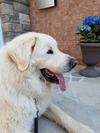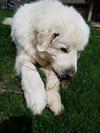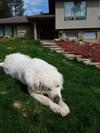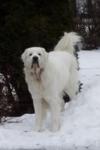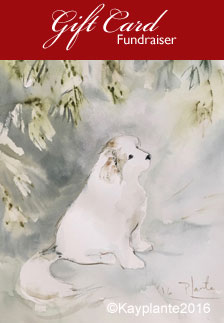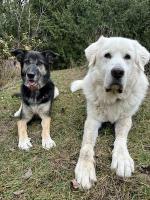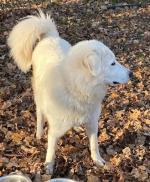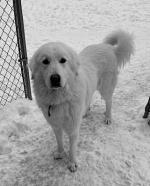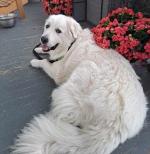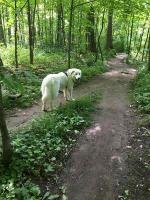Bear

It is with great sadness that we announce that Bear, alumni 2017, has passed away. Our heartfelt condolences go to his family.
From his owner:
Yesterday we said goodbye to my beautiful big boy Bear Bear. Bear came to me at 6.5 yrs old from a wonderful family who's lifestyle changed. They kept in touch and visited often. Bear was part of my wonderful trio and will be missed. He will be a great addition to the angels up above.... RIP
Bear Bear Dec 22 2010 - Aug 21 2021
*ADOPTED*
Update: Bear was surrendered to us in the summer of 2017. He was introduced to Anne (and Izzy). He is now with Anne and settling in. He is big and beautiful and all that is owner told us.
About Bear:
Bear is a six-year old who loves to spend his days outside in between walks and hikes but will come in to snuggle up for the night. He is good with people, children, dogs, and animals. Always, proper introductions are required.
He is very gentle and well-trained.
Like a Pyr does, he barks at passersby, and when visitors arrive he greets them with a wagging tail and kisses once the barking is done.
Unfortunately, his people have downsized and Bear wants more space which must include a well-fenced (5 foot minimum) large yard.
If he is left alone for too long in the house, 3-4 hours, he will scratch the door to get out since that is where he likes to be.
About the Pyr in brief:
They are beautiful dogs with great temperaments given the right breeding, socialization, care including diet and training.
Bot working and companion dogs require a good weekly grooming with a slicker brush and comb to keep them mat free and their skin healthy (hence, pain free from the pulling of mats as they move), and cutting their nails including their dew claws every couple of weeks to a month. This includes working dogs. They molt twice a year and all year round so your vacuum stays full. NEVER shave a Pyr. Their double coats keep them cool in summer and warm in winter.
Their instinct it to wander. Therefore, they require at least a 6-foot secure fence in a large yard in which they can play, run and watch over. No tie outs of any type for these guys. It can lead to aggression since they cannot fully watch over their territory. If they are out all day, as they usually prefer, they need shelter from the elements and fresh water.
They bark more than most dogs and neighbours do complain. That is a common reason for people surrendering their Pyrs (they didn't do their research). Their bark is what deters predators and it is instinct to them. That and marking their territory. To take away their bark is to take away who they are. The barking can be managed but it takes time, patience and consistency with positive-reinforcement training. Never use shock collars. This is cruel since barking is instinctive and a tool of their trade.
They dig holes in your garden to stay cool in summer.
Diet is very important in having a healthy dog. The best food is raw.
They require much socialization and handling as pups onward with many different people and other dogs.
They require positive-reinforcement training (a trainer who shows you how to work with a clicker and follow people such as Dr. Sophia Yin, Dr. Ian Dunbar, Karen Pryor and Bev Hurst). Pyrs, nor any dogs, take kindly to any kind of punishment. It will lead to aggression.
It's important to work with the dogs as if in a dance and you are leading. Rewards for good behaviour and redirect for unwanted behaviour. It's up to you to make them a good canine citizen. When engaging a trainer, ensure they use positive-reinforcement training and show you how to manage your dog. Never send a dog away for training. You are the one working with the dog, not a trainer.
To train a Pyr is not like training some other dogs. They are not eager-to-please and just as soon walk away from you than do as you say. They have been used for years as guardian livestock dogs because they do not require human intervention to tell them how to do their job. Lots of patience, consistency and time is required to work with them. If you want an obedient dog, this is not the dog for you.
They require regular walks, of course, so they get out and see the world. They must be leashed because they will wander. Again, because they are so good at wandering they have been used to wander with sheep as they watch over them. Do not use choker collars or pinch collars. A harness that hooks in front is easiest on the dog should he pull. How to choose what to use.
There are those in need of a home because someone didn't realize they would get so big, bark so much, leave so much hair in the house, wander, and require work.
It is very important to do your research on any breed before deciding if they are a good match for your family. Please start here:
Great Pyrenees Club of Southern Ontario
We never want to see these dogs fail so it's important that children learn how to behave with dogs and that parents never leave their children alone with a dog. Here is a link on that subject:
Best Dogs for Children
Comments for Bear
|
||
|
||
Breaking News
-
Courtesy - Bear
Apr 09, 25 09:09 AM
Bear DOB: October 2018 Location: Midland, Ontario Pyr/Maremma? mix Single family home with a large securely-fenced property or a hobby farm. Purchased/adopted -
Courtesy Post - Willow
Apr 09, 25 09:07 AM
DOB: March 26th, 2022 Location: London Ontario Cross Pyr/Collie Obtained her privately through a friend. How long have you had her? 10 months Spayed -
Lucy
Apr 09, 25 09:06 AM
*Foster-to-Adopt* or *Foster* DOB: January 3, 2024 Location: Acton, Ontario She will need a single-family home with a securely fenced yard of at least -
Remi
Apr 09, 25 07:44 AM
Location: Acton, Ontario DOB: February 2024 This sweet white fluffy Remi has a sad story. Remi, while his family was in the midst of moving, escaped and -
Grieving Dog
Apr 04, 25 06:17 PM
Background: I am seeking some feedback if anyone has had experience with bonded pairs. Thank you! We have been fortunate to love 2 x almost 10 year -
Leo
Mar 12, 25 06:32 AM
*ADOPTED* DOB: September 2023 (almost 1.5-years-old) Location: Acton, ON Single family home with a securely fenced yard required. This sweetheart was -
Buster
Mar 10, 25 03:36 PM
*Buster is going back to his original family as things have brightened up in their lives and he'll have a wonderful life on acreage.* Buster had to come -
Courtesy - Maya
Jan 08, 25 05:35 PM
*ADOPTED* Location: Dunnville, ON DOB: Jan. 3, 2021 (3.5 years) Spayed Companion Dog, Pyr mix Good with children. Single family home. Raw diet (species-appropriate)



